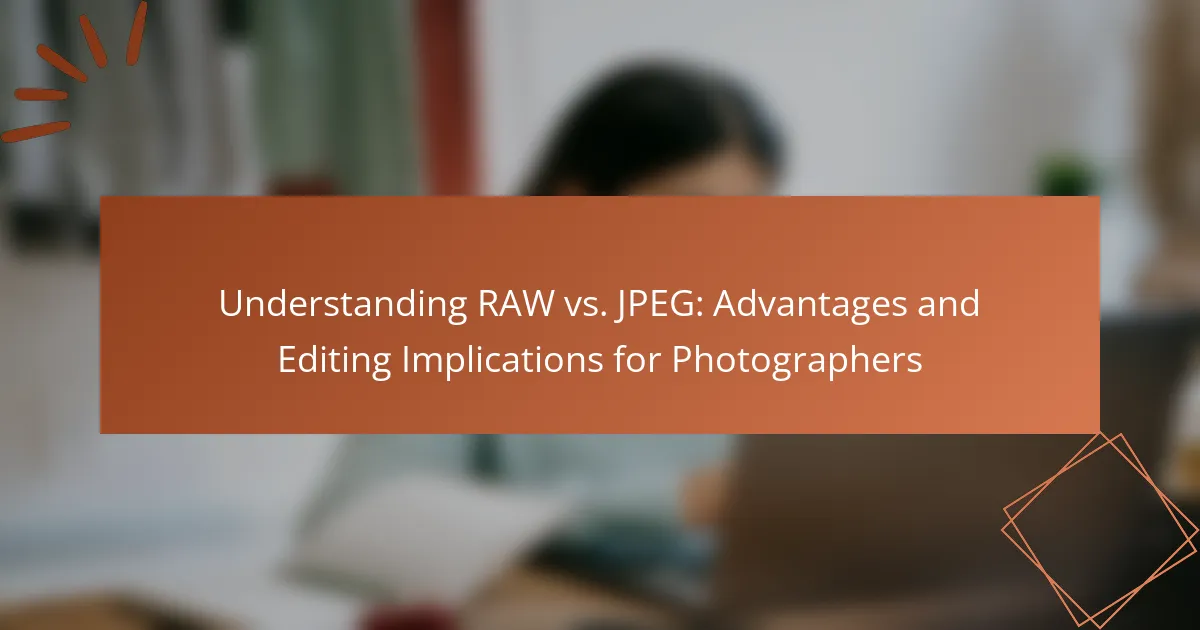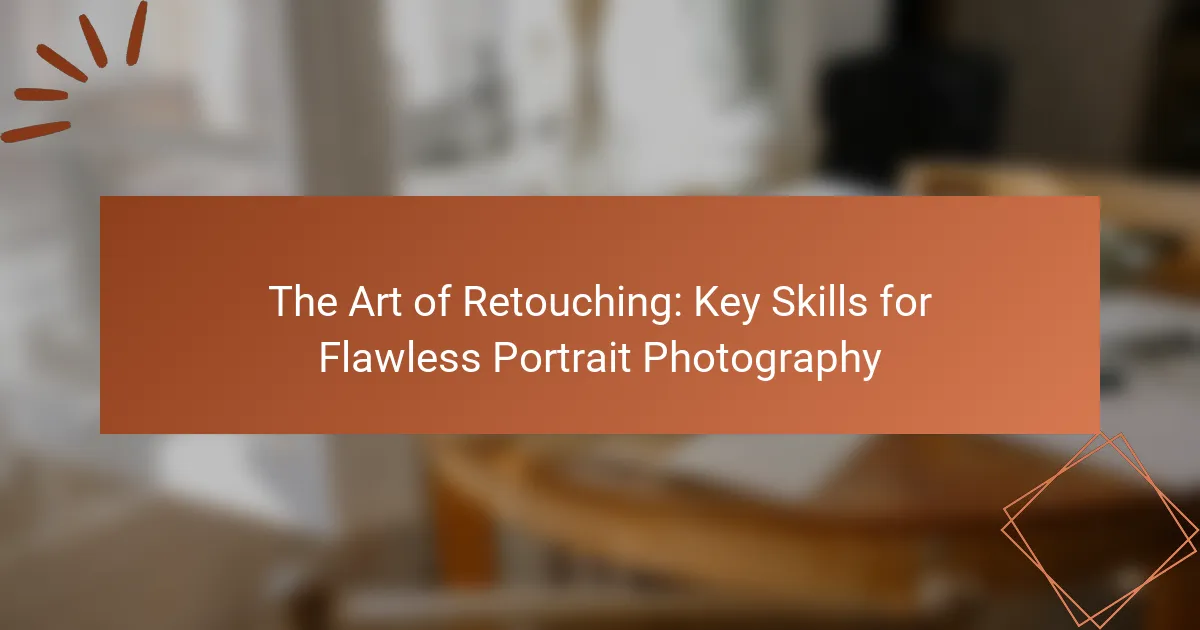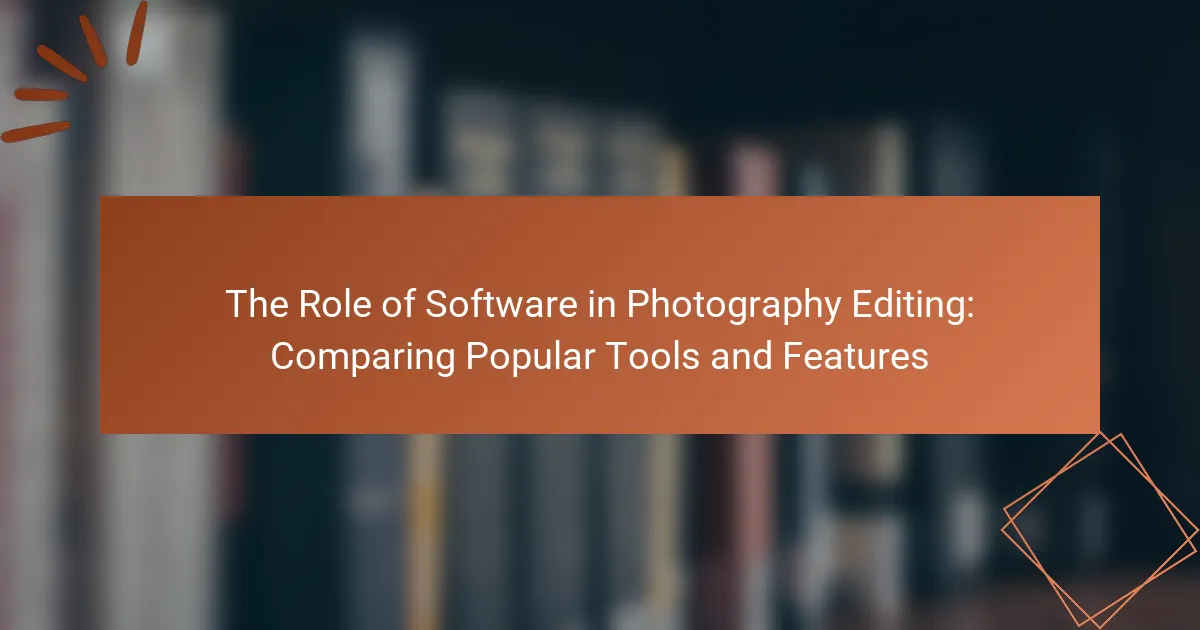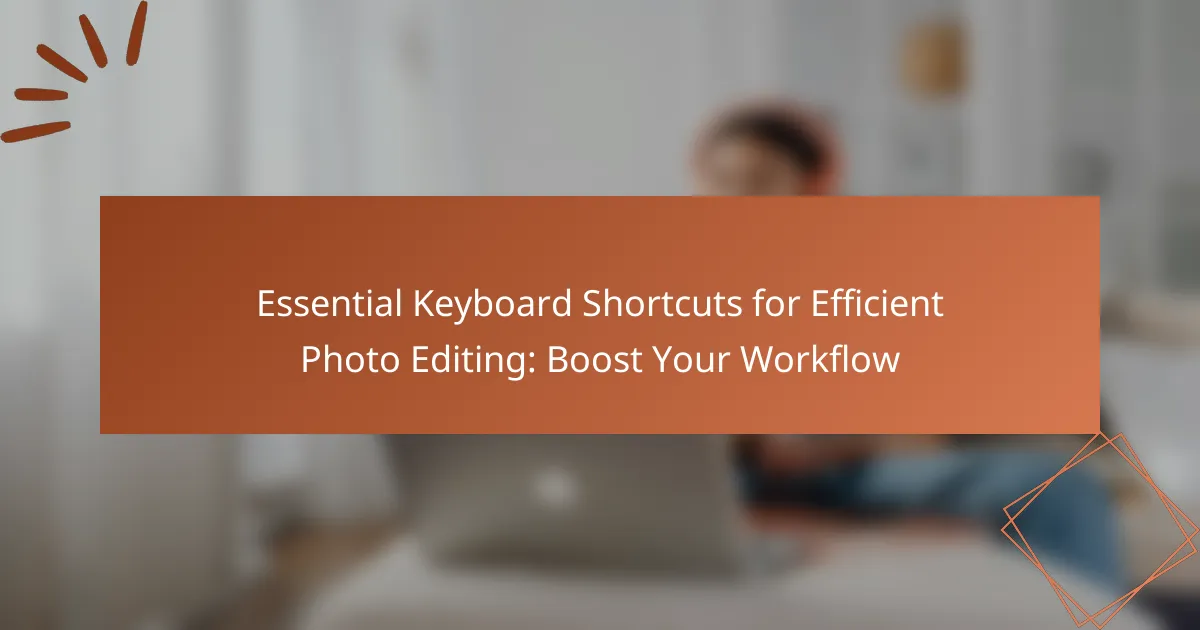Developing a personal editing style in photography is essential for reflecting a photographer’s unique aesthetic and creative vision. This article outlines the process of creating a distinctive editing style, emphasizing the importance of experimentation with techniques, tools, and software. It highlights how consistency in editing contributes to brand recognition and discusses various sources of inspiration, including the study of other photographers and art history. Additionally, the article provides practical tips on refining skills through practice, seeking feedback, and documenting the editing journey. By engaging with diverse visual art forms, photographers can evolve their editing styles over time.
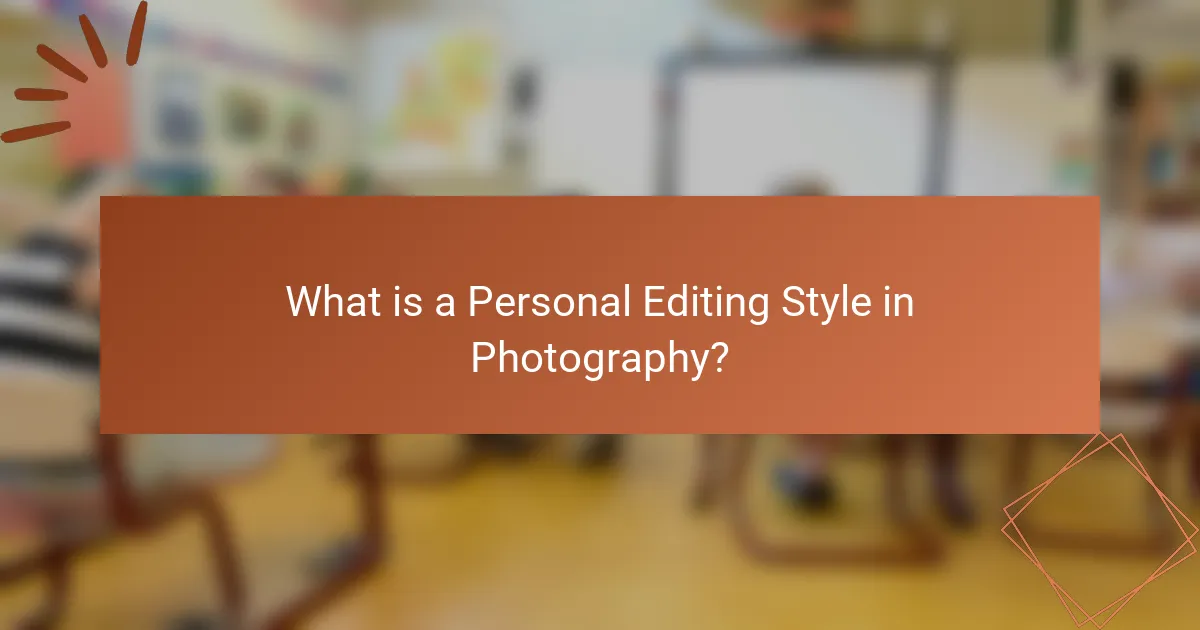
What is a Personal Editing Style in Photography?
A personal editing style in photography is a unique approach to post-processing images. It reflects a photographer’s individual aesthetic and creative vision. This style influences color grading, contrast, and overall mood. Photographers often develop their editing style through experimentation and practice. Consistency in editing helps establish a recognizable brand. Many photographers study the works of others for inspiration. This can lead to the development of a distinctive style over time. Personal editing styles can evolve with experience and changing artistic preferences.
Why is Developing a Personal Editing Style Important for Photographers?
Developing a personal editing style is important for photographers because it establishes their unique visual identity. A distinct style helps photographers stand out in a competitive market. It allows them to convey emotions and narratives through their work. Consistency in editing enhances brand recognition among audiences. Personal style can also reflect a photographer’s artistic vision and values. This authenticity resonates with clients and viewers. Ultimately, a well-defined editing style can lead to greater artistic fulfillment and professional success.
How does a Personal Editing Style Reflect a Photographer’s Vision?
A personal editing style reflects a photographer’s vision by showcasing their unique perspective and artistic choices. This style influences color palettes, contrast levels, and overall mood. For example, a photographer might favor warm tones to evoke nostalgia. Alternatively, cooler tones might be used to convey a modern or serene atmosphere. The consistency in their editing approach helps establish a recognizable brand. This brand identity can attract specific audiences who resonate with that vision. Additionally, personal editing choices can highlight particular subjects or themes. For instance, a focus on natural light may emphasize a photographer’s love for the outdoors. Ultimately, a personal editing style serves as a visual language that communicates the photographer’s intent and creativity.
What Role Does Consistency Play in Personal Editing Styles?
Consistency is crucial in personal editing styles as it establishes a recognizable aesthetic. A consistent editing style enhances a photographer’s brand identity. This uniformity in color grading, contrast, and composition fosters viewer familiarity. Research indicates that consistent visual themes increase engagement and retention in photography. For instance, studies show that cohesive portfolios attract more clients. Consistency also aids in storytelling, allowing images to convey a unified message. Overall, a consistent editing style strengthens the photographer’s unique voice and marketability.
What Are the Key Elements of a Personal Editing Style?
Key elements of a personal editing style include consistency, color palette, and technique. Consistency ensures that all images maintain a similar look and feel. A defined color palette enhances the photographer’s brand identity. Technique encompasses the methods used for editing, such as contrast adjustments and sharpening. These elements work together to create a cohesive visual narrative. Photographers often develop their style through practice and experimentation. Over time, this leads to a unique signature that distinguishes their work from others.
Which Techniques Can Define a Personal Editing Style?
Techniques that can define a personal editing style include color grading, contrast adjustment, and cropping. Color grading allows photographers to set a mood or tone in their images. Contrast adjustment enhances the visual impact by emphasizing light and shadow. Cropping helps in focusing the viewer’s attention on the subject.
Additionally, the use of presets can streamline the editing process while maintaining a consistent look. Incorporating textures or overlays adds uniqueness to images. Finally, the choice of sharpness affects the overall clarity and detail in a photograph. These techniques collectively contribute to a distinct personal editing style.
How Can Color Grading Influence Your Editing Style?
Color grading significantly influences your editing style by altering the mood and tone of your images. It allows you to create a specific atmosphere that aligns with your artistic vision. Different color palettes evoke various emotions; for example, warm tones can create feelings of comfort, while cool tones may convey calmness or detachment.
Additionally, color grading can enhance the storytelling aspect of your work. By manipulating colors, you can guide the viewer’s attention and highlight key elements within the frame. Consistent color grading across your portfolio helps establish a recognizable style.
This approach can differentiate your work from others, making it more memorable. Studies show that color can affect perception and emotional response, reinforcing its importance in visual storytelling.
What Common Mistakes Should Photographers Avoid When Developing Their Style?
Photographers should avoid several common mistakes when developing their style. One mistake is imitating others without adding personal touches. This can lead to a lack of originality and creative stagnation. Another mistake is neglecting to experiment with different techniques. Experimentation helps in discovering unique aspects of one’s style. Additionally, photographers often rush the editing process. Taking time to refine edits can significantly enhance the final image.
Failing to seek constructive feedback is another error. Feedback from peers can provide valuable insights and help in growth. Over-reliance on presets can also hinder the development of a unique style. While presets can be useful, relying solely on them may limit creativity. Lastly, photographers sometimes ignore the importance of consistency. A consistent style helps in building a recognizable brand. Avoiding these mistakes can lead to a more defined and personal photographic style.
How Can Over-Editing Impact Your Photography?
Over-editing can negatively impact your photography by distorting the original image. It may lead to unnatural colors and excessive contrast. This can result in a loss of detail, making the photograph appear flat or unrealistic. Over-editing can also distract viewers from the subject of the photo. In extreme cases, it can create an artificial look that detracts from the emotional impact. Research indicates that viewers often prefer images that maintain a natural aesthetic. A study published in the Journal of Visual Communication found that authenticity in photography is crucial for audience engagement.
What Are the Signs of an Inconsistent Editing Style?
Signs of an inconsistent editing style include varying color tones across images. This inconsistency can confuse the viewer about the photographer’s intent. Another sign is differing levels of sharpness and clarity. Images may appear either overly processed or too soft, disrupting visual coherence. Inconsistent cropping and framing can also indicate a lack of a defined style. Images may have different aspect ratios or focal points, leading to a disjointed narrative. Lastly, the use of filters and effects that change from one image to another can create a lack of uniformity. These signs collectively suggest that a photographer has not yet established a cohesive editing approach.
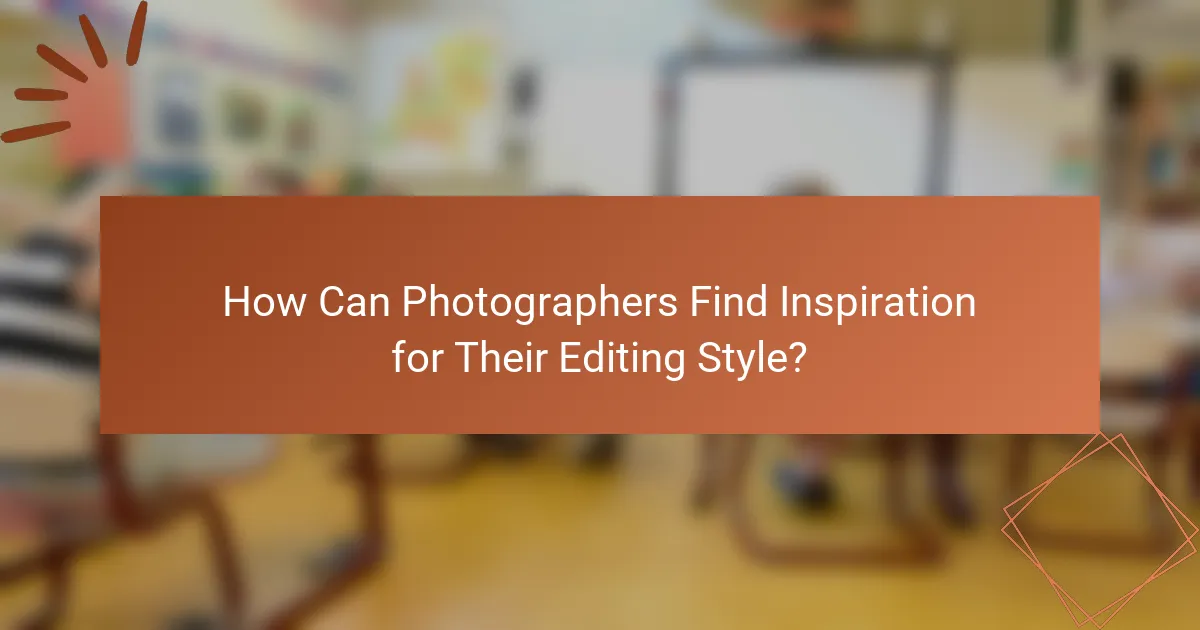
How Can Photographers Find Inspiration for Their Editing Style?
Photographers can find inspiration for their editing style by exploring diverse sources of visual art. They can study the work of other photographers to understand various techniques and aesthetics. Analyzing different genres of photography, such as portrait, landscape, or street photography, can also provide new ideas. Engaging with art history and movements, like Impressionism or Surrealism, may influence their editing choices. Experimenting with editing software and tools allows photographers to discover unique styles. Participating in workshops or online courses can provide fresh perspectives and skills. Finally, keeping a mood board of inspiring images can help crystallize their editing vision.
What Sources of Inspiration Can Photographers Explore?
Photographers can explore various sources of inspiration to enhance their creativity. Nature, including landscapes and wildlife, offers rich visual stimuli. Urban environments provide unique architecture and street scenes. Art galleries and museums showcase diverse styles and techniques. Books and magazines on photography present different perspectives and ideas. Social media platforms allow photographers to connect and share their work. Workshops and photography classes foster skill development and inspiration. Collaborating with other photographers can introduce new concepts and techniques. Traveling to new locations exposes photographers to different cultures and environments.
How Can Following Other Photographers Help in Developing Your Style?
Following other photographers can significantly aid in developing your style. Exposure to diverse techniques broadens your creative perspective. Observing their compositions helps identify elements that resonate with you. Analyzing their editing choices can inspire new approaches to post-processing. Engaging with their work fosters a sense of community and feedback. This interaction can lead to discovering your unique voice in photography. Research shows that learning from peers enhances skill development and creativity. Thus, following other photographers is a valuable strategy for personal growth in photography.
What Role Do Art and Design Influence Personal Editing Styles?
Art and design significantly influence personal editing styles by shaping visual aesthetics and guiding creative choices. The principles of color theory, composition, and balance from art inform how photographers edit images. For instance, a photographer may apply complementary colors to enhance mood, inspired by color palettes used in famous artworks. Design elements, such as leading lines and framing, can dictate how images are cropped and presented. Historical art movements, like Impressionism, often inspire editing styles that emphasize light and texture. Studies show that visual art education enhances a photographer’s ability to make informed editing decisions. Therefore, the integration of art and design into editing practices leads to more cohesive and expressive photographic work.
How Can Experimentation Lead to a Unique Editing Style?
Experimentation can lead to a unique editing style by allowing photographers to explore different techniques and approaches. Trying various editing software and tools can reveal unexpected results. Combining styles from different genres can also create distinctive outcomes. For example, blending realism with abstract elements can yield innovative visuals. Photographers who experiment often discover their preferences and strengths. This process helps in defining a personal aesthetic. Additionally, analyzing the effects of different adjustments fosters creativity. Ultimately, consistent experimentation shapes a photographer’s signature style over time.
What Techniques Should Photographers Experiment With?
Photographers should experiment with techniques such as long exposure, double exposure, and high dynamic range (HDR) imaging. Long exposure captures motion, creating ethereal effects in landscapes or night photography. For instance, a shutter speed of several seconds can blur moving water, enhancing the image’s mood. Double exposure combines two images into one frame, allowing for creative storytelling and artistic expression. This technique can be achieved in-camera or through editing software. HDR imaging captures a wider range of light and detail by blending multiple exposures. It is particularly useful in high-contrast scenes, ensuring both shadows and highlights are well-represented. Each of these techniques encourages photographers to push their creative boundaries and develop a unique editing style.
How Can Feedback from Peers Enhance Your Editing Style?
Feedback from peers can significantly enhance your editing style by providing diverse perspectives. It allows you to identify strengths and weaknesses in your work. Peers may notice details you overlook, offering constructive criticism. This input can lead to new techniques or approaches in your editing process. Collaboration fosters creativity and innovation in your style. Studies show that peer feedback improves skills and confidence in creative tasks. Engaging with peers creates a supportive community that encourages experimentation. Ultimately, this exchange of ideas refines your unique editing style.
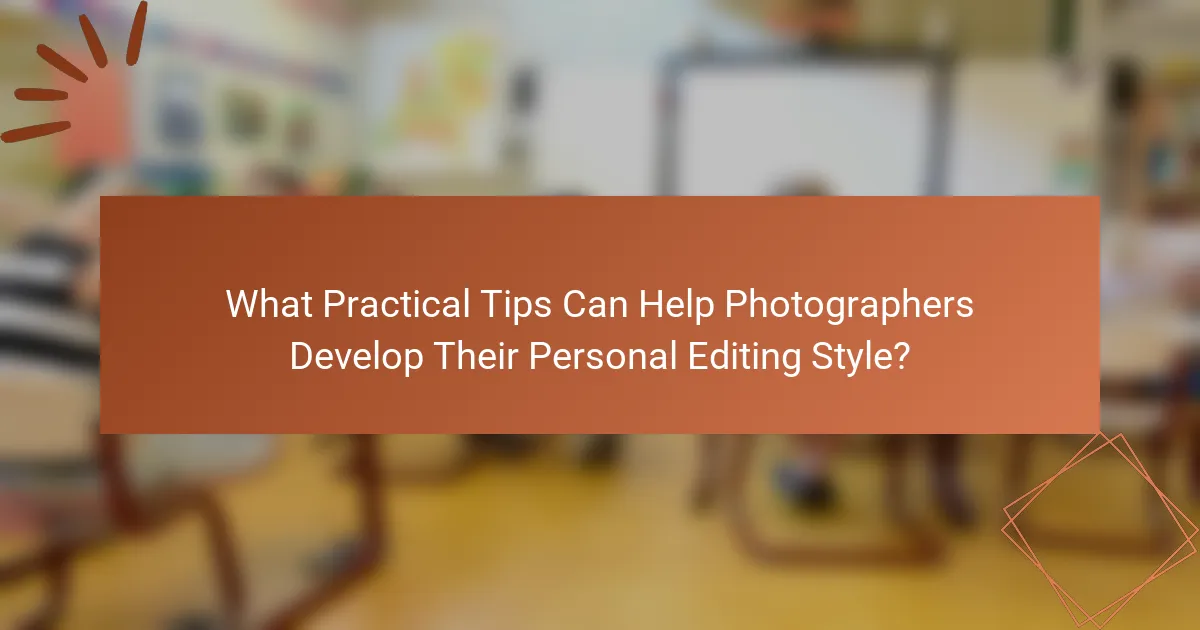
What Practical Tips Can Help Photographers Develop Their Personal Editing Style?
Photographers can develop their personal editing style by experimenting with various techniques and tools. They should explore different editing software to find what suits their workflow. Understanding color theory can enhance their ability to create mood and emotion in their images. Consistently applying specific presets can help establish a recognizable style. Photographers should also analyze the work of their favorite artists for inspiration and guidance. Regular practice is essential for refining their skills and preferences. Seeking feedback from peers can provide valuable insights into their editing choices. Documenting their editing process will help track their evolution and preferences over time.
How Can Setting Goals Aid in Developing Your Editing Style?
Setting goals aids in developing your editing style by providing clear direction and focus. Specific goals help identify the aspects of editing you want to improve. This can include mastering color grading or enhancing composition techniques. Setting measurable objectives allows tracking progress over time. For example, aiming to complete a certain number of edits per week establishes a routine. Goals also encourage experimentation with different styles and techniques. This experimentation can lead to discovering unique attributes of your editing style. Research indicates that goal-setting enhances motivation and performance in creative tasks.
What Should Photographers Focus on When Setting Their Editing Goals?
Photographers should focus on clarity, consistency, and creativity when setting their editing goals. Clarity ensures that the subject of the photograph is easily discernible. Consistency in editing style helps build a recognizable brand. Creativity allows photographers to express their unique vision through their work. Setting specific objectives, like color grading or contrast adjustments, can guide the editing process. Research indicates that a defined editing style can enhance audience engagement by up to 50%. This shows the importance of focusing on these aspects to achieve effective editing goals.
How Can Regular Practice Improve Your Editing Skills?
Regular practice can significantly enhance your editing skills. Consistent editing helps you understand various techniques and tools. It allows you to experiment with different styles and approaches. Over time, this practice builds your confidence in decision-making. You become more adept at identifying elements that enhance a photograph. Studies show that deliberate practice leads to mastery in creative fields. For instance, a study by Ericsson et al. (1993) emphasizes the importance of focused practice in skill development. Regular engagement with editing software also improves technical proficiency. This cumulative experience fosters a unique editing style that reflects your artistic vision.
What Tools and Software Are Recommended for Editing?
Adobe Lightroom is a highly recommended tool for editing photos. It offers powerful features for color correction and image enhancement. Another popular option is Adobe Photoshop, known for its advanced editing capabilities. Capture One is also favored by professionals for its exceptional color grading tools. Affinity Photo provides a cost-effective alternative with robust editing features. Lastly, GIMP is a free software that offers a wide range of editing tools. These programs are widely used in the photography industry for their versatility and effectiveness.
How Can Different Editing Software Affect Your Style?
Different editing software can significantly influence a photographer’s editing style. Each software offers unique tools and features that shape the editing process. For example, Adobe Lightroom provides extensive color grading options, which can lead to vibrant and dynamic images. In contrast, Photoshop allows for detailed retouching and manipulation, encouraging a more artistic approach.
Software like Capture One is known for its color accuracy, which can promote a more natural look in images. On the other hand, mobile editing apps may prioritize speed and simplicity, resulting in a more casual editing style.
The choice of software can also affect workflow efficiency. A streamlined process can encourage experimentation, leading to a more diverse portfolio. Conversely, complex software may lead to a more cautious approach, as users may spend more time perfecting individual edits.
Ultimately, the editing software chosen can either enhance or limit a photographer’s creative expression.
What Features Should Photographers Look for in Editing Tools?
Photographers should look for features like user-friendly interfaces, advanced color correction, and customizable presets in editing tools. User-friendly interfaces enable quick navigation and efficient workflow. Advanced color correction tools allow for precise adjustments to enhance image quality. Customizable presets help streamline repetitive tasks and maintain consistency in editing style. Additionally, support for various file formats is crucial for compatibility with different camera outputs. Batch processing capabilities can save time by allowing multiple images to be edited simultaneously. Finally, integration with other software can enhance the editing process by providing additional functionalities. These features collectively enhance the editing experience for photographers.
How Can Photographers Stay True to Their Editing Style?
Photographers can stay true to their editing style by consistently applying their unique vision and techniques. Establishing a signature editing style involves understanding personal preferences in color, contrast, and composition. Regularly practicing and refining these techniques helps maintain consistency across different projects. Utilizing presets or custom filters can further streamline the editing process while preserving the desired aesthetic. Engaging with a community of like-minded photographers can provide valuable feedback and inspiration. Additionally, revisiting past work can reinforce the core elements of the established style. Ultimately, dedication to personal artistic expression is key to staying true to an editing style.
What Strategies Can Help Maintain Consistency Over Time?
Establishing a clear editing workflow is essential for maintaining consistency over time. A defined process helps photographers follow a systematic approach to their editing. This includes organizing files, applying preset filters, and using the same software tools consistently. Regularly reviewing past edits ensures adherence to the established style. Additionally, creating a style guide can serve as a reference for color grading, contrast, and composition techniques. Using the same camera settings during shoots supports a uniform look in images. Furthermore, seeking feedback from peers can help identify areas for improvement and reinforce consistency.
How Can Self-Reflection and Review Improve Your Editing Style?
Self-reflection and review enhance editing style by allowing photographers to critically assess their work. This process helps identify strengths and weaknesses in their techniques. Regularly reviewing edits can reveal patterns in choices, such as color grading or composition. Photographers can then adjust their style based on these insights. Furthermore, self-reflection fosters a deeper understanding of personal artistic vision. It encourages experimentation with new techniques that align with evolving preferences. Studies show that self-assessment leads to improved skills over time. By tracking progress through review, photographers can notice significant growth in their editing style.
Developing a personal editing style is essential for photographers as it establishes their unique visual identity and enhances brand recognition. This article explores the key elements of personal editing styles, including consistency, color grading, and technique, while highlighting the importance of experimentation and feedback. It also addresses common mistakes to avoid and practical tips for refining editing skills, emphasizing how tools and software can influence a photographer’s style. Additionally, the article discusses sources of inspiration and strategies for maintaining consistency over time, ultimately guiding photographers to articulate their artistic vision effectively.
